Why hydrangea does not bloom in the garden: what to do, how to care for the bush to bloom magnificently
It is worth recognizing that hydrangea is one of the most beautiful and long-flowering perennials, which can be in the form of a shrub or a small tree. Depending on the variety, it has very beautiful inflorescences of various shapes, and can also change color during its flowering.
But it often happens that the hydrangea stops blooming or the flowering becomes not so abundant and bright. Why this is happening, and what needs to be done so that the hydrangea begins to bloom again magnificently and brightly - this will be discussed below.
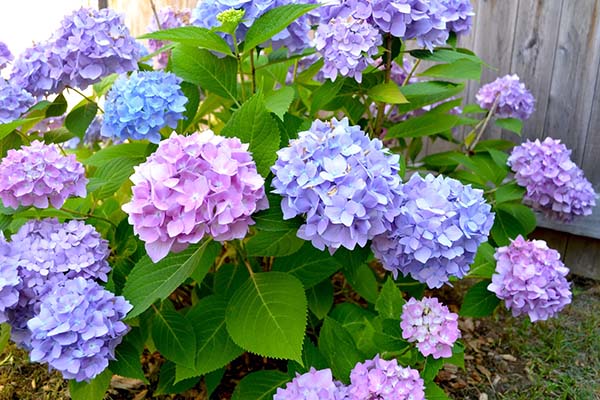
Content
- 1 Why hydrangea does not bloom: reasons and what to do, how to properly care for it to make it bloom
- 1.1 The time has not come
- 1.2 Planting not according to the rules: wrong choice of location, soil or wrong planting of a seedling
- 1.3 Difficulties in adaptation: the shrub does not take root in any way
- 1.4 Lack of moisture or waterlogging
- 1.5 Wrong choice and untimely fertilization, excess or lack of fertilizing
- 1.6 Soil acidification is not carried out
- 1.7 Incorrect pruning in spring and / or autumn
- 1.8 Lack of shelter for the winter
- 1.9 Diseases and pests
Why hydrangea does not bloom: reasons and what to do, how to properly care for it to make it bloom
Most often, hydrangea does not bloom due to the fact that it was originally planted incorrectly or grooming not according to the rules: they do not feed on time, often violate the irrigation regime, pruning is carried out incorrectly, they forget or incorrectly cover for the winter. Sometimes pests attack this flowering shrub or it is affected by fungal diseases. As a result, the perennial weakens and blooms poorly or stops flowering altogether.
To prevent this from happening with hydrangeas in the garden, you need to remember about the main agrotechnical measures, on the accuracy of compliance with which the abundant flowering of these shrubs depends.
Next, let's try to figure out the main reasons for the absence or problems with the flowering of hydrangeas in the garden.
The time has not come
The main mistake of many novice flower growers is as follows - they expect hydrangea to bloom almost immediately after planting seedlings in open ground. But you need to understand that these flowering shrubs, planted in a permanent place in the spring, during the season they will only take root and grow roots. By the fall, most varieties will only have flower buds that will bloom only in the next season after planting. If the seedlings were planted in autumn, then they can bloom next year.
Therefore, you should not panic if after planting your hydrangea does not begin to bloom - it just has not yet come for this. It is also possible that the flowering period will move another season or two if planting or care conditions are not met.
Worth knowing! Most often, hydrangea begins to bloom only at 3 or 4 years, and from 5 years - abundantly. Therefore, as a rule, 3-4-year-old seedlings are sold.
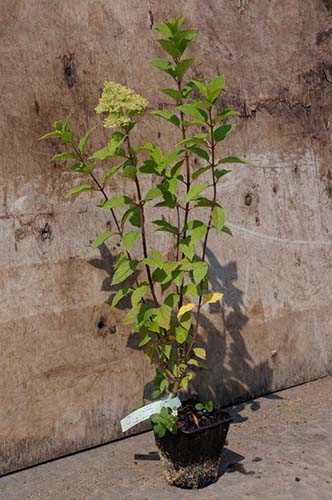
Planting not according to the rules: wrong choice of location, soil or wrong planting of a seedling
The place for planting these flowering perennials should be sufficiently well lit in the morning or evening, but not with bright afternoon sunlight, which can burn the delicate foliage of hydrangeas. Also suitable for these shrubs and very light partial shade.
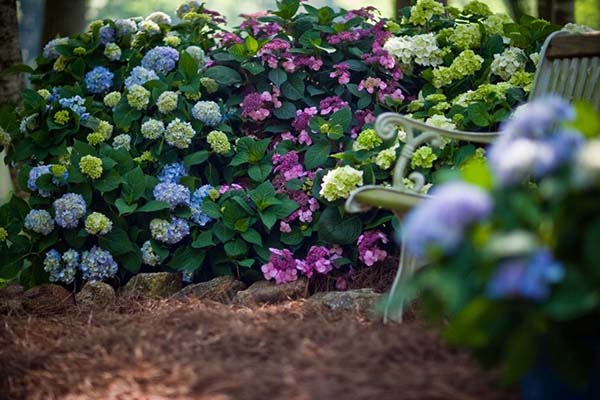
In general, it is believed that treelike and paniculate Hydrangeas bloom best when there is morning or evening sun, so they are best planted in light shade. In addition, in a too open space, the shrub will fade very quickly, and it will have to be watered more often, because hydrangeas, in principle, are moisture-loving.
Important! The more sun, the better the bloom, but if there is too much sun, the bloom will be short-lived. Accordingly, in the shade, the plant will bloom longer, but not abundantly, so you need to find the optimal balance.
Another thing, large-leaved hydrangea... This is truly a partial shade plant, in such conditions it will bloom very well.
It is worth understanding! Despite the fact that hydrangea is considered a shade plant, it will bloom profusely only if there is good lighting in the morning (before lunch) or in the evening (from 5-6 hours until sunset).
It is equally important that the area where hydrangeas are grown is well protected from east and north windsthat can simply break all your beautiful flowers.
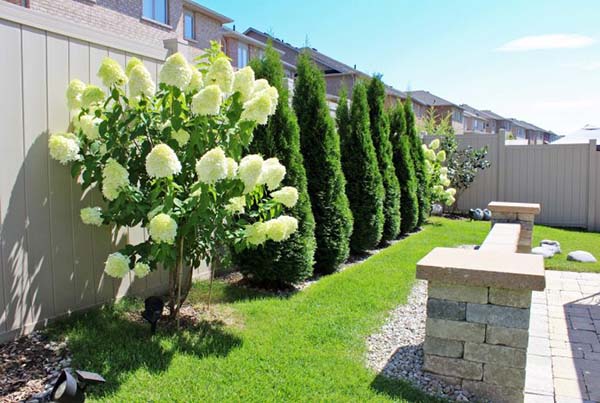
Advice! An ideal place in the garden for planting hydrangeas would be an area near a fence or garden house.
But it is not worth planting under trees, since they will create a shade (sometimes excessive), and also take most of the necessary moisture, therefore, the plant will not receive the required nutrition and will not bloom.
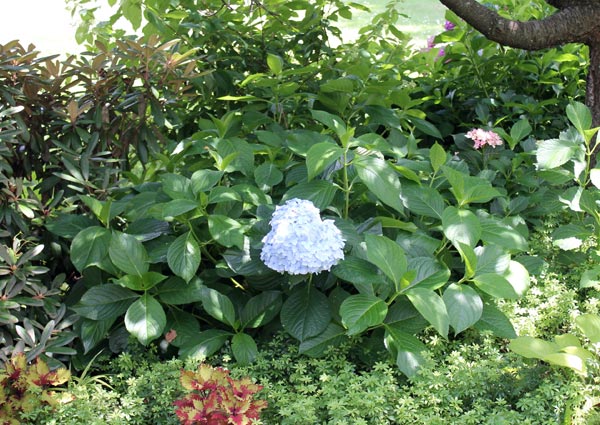
Hydrangea is also demanding on the composition of the soil, namely on the degree of its acidity (required 5.2-5.5 pH, maximum up to 6.2). Although most varieties grow well on slightly acidic or neutral soils (for example, tree hydrangea), but here in alkaline soils, these perennials begin to hurt, do not bloom and die as a result.
Therefore, it is imperative prepare the landing pit correctly for planting hydrangeas, or rather to do acidic substrate to fill it (holes). Suitable for this sour high (or brown) peat, coniferous sawdust, coniferous litter or pine bark (you can collect all this in the forest).
Important! In no case in the substratecan't add dolomite flour, lime or wood ash (for example, as a potash fertilizer), because all these are deoxidizers (reduce acidity), but we need, on the contrary, acidifiers (increase).
The optimal size of the planting pit for young and small 1-2 year old hydrangea seedlings is 30 by 30 cm, for older and large 3-4 year olds - 50 by 50 cm.
Note! Learn more about when (timing) and how to properly plant hydrangeas in your garden, you can from the following articles about planting in spring and in the fall.
Difficulties in adaptation: the shrub does not take root in any way
Often, after planting purchased hydrangea seedlings to a permanent place in the open field, they adapt for a long time in a new area or even begin to hurt, which means that there can be no talk of any flowering. The main reasons may be as follows:
- Previous owners (if they gave it to you or bought it at the garden center) added to the soil too much fertilizerso that the plant grows faster. And in a new place you filled the landing pit with fairly poor soil (they forgot to add phosphorus-potassium fertilizers), so the hydrangea does not grow in any way and, accordingly, does not bloom.
Advice! 30-40 grams of potassium fertilizer (for example, potassium sulfate) and 60-80 grams of phosphoric fertilizer (superphosphate).
- The same happens if you transplant hydrangea from initially acidic soil to slightly acidic (especially if it is a seedling with an open root system).
- If the purchased seedling with a closed root system, then when it is planted in a permanent place you can not shake off the earthen ball, especially prune the root system.
Advice! Actually, always it is preferable to buy seedlings in containers (with a closed root system).
Lack of moisture or waterlogging
The correct watering regime for the plant is also very important. Hydrangea is a flower that drinks a lot of water and always drinks, which means that for abundant flowering it needs a constantly moist soil. But it is also impossible to pour it, the bush can rot. However, in this particular case, it is better to pour over than not to top up.
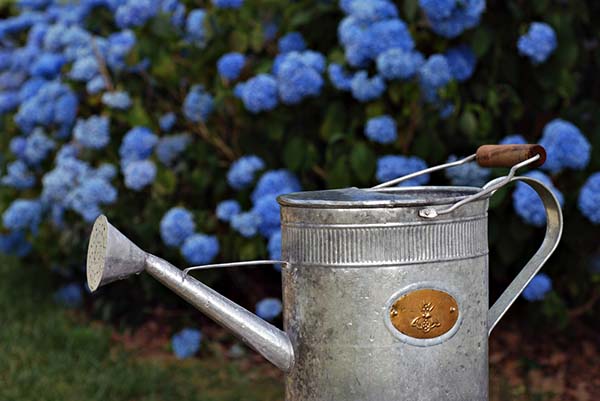
If the soil under the bushes is too dry, then the plant is sluggish. What a bloom here! Therefore, in the summer, hydrangeas need to be watered at least 2 times a week. And it is better every other day or even every day if the heat is above +30. Also, for better moisture retention, it is recommended to mulch the soil near the bushes.
Note! If your soil is clayey, therefore, moisture will stagnate in it, so you must definitely do good drainage at the bottom of the planting pit when planting.
Wrong choice and untimely fertilization, excess or lack of fertilizing
Important! The site already has a detailed article about feeding hydrangeas in spring and summer.
An excess of fertilizers in the soil is also harmful to this flowering perennial, as is their lack. Special it is dangerous to use nitrogen fertilizers in the second half of summer and even more so in autumn in a large volume, because nitrogen contributes to the growth of vegetative mass to the detriment of flowering. And if such a top dressing is introduced in the autumn period, then new shoots begin to actively grow in the shrub, which do not have time to sufficiently develop and mature before the onset of frost. As a result, they simply freeze out and die in winter. In addition, the growth of shoots in autumn leads to the fact that nutrients are spent by the plant not for preparing for winter, but for growing shoots, which significantly weakens the hydrangea, and as a result, the plant may freeze in winter.
Therefore, fertilizers, mainly containing nitrogen, are applied to the soil under hydrangeas only in spring, and in the summer and autumn, top dressing should consist for the most part (a little nitrogen is still allowed) of phosphorus and potassium fertilizers. Such fertilizers activate the appearance of inflorescences (contribute to budding) and excellent flowering, and in the fall they help shrubs to lay flower buds and better prepare for the onset of cold weather.
Thus, for example, if you realized that you have overfed the hydrangea with nitrogen, then you should fertilize it with an increased amount of potash-phosphorus fertilizers, but within reasonable limits.
Fertilization should be started in early spring, when the buds on the shoots are just beginning to swell.
Note! It is advisable to dissolve each of the fertilizers in water (all doses are written for 10 liters of water and 1 square meter of the flower bed) and water at the root.
- So, the first feeding after waking up should consist of nitrogen fertilizers, as well as phosphorus and potassium.
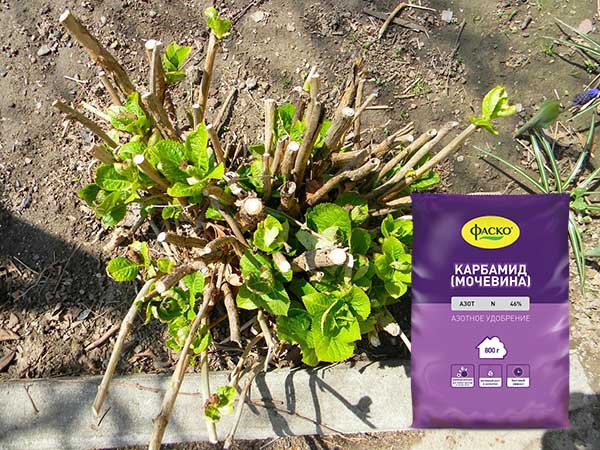
- The second is the time of budding - potassium-phosphorus fertilizers (+ nitrogen is allowed).
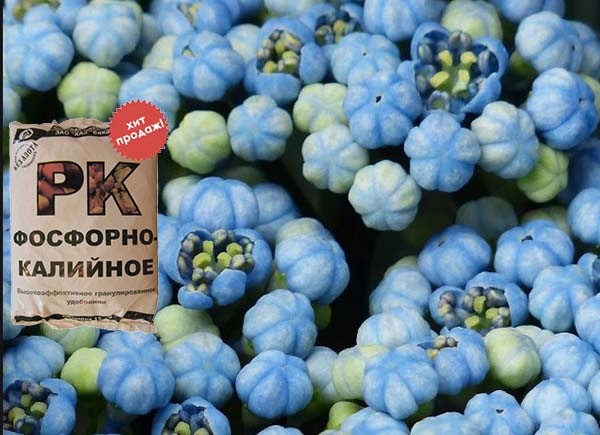
- During flowering (in summer), you can, if desired, again feed with potassium-phosphorus fertilizers.
By the way! The site already has a detailed article about how and what to fertilize hydrangeas in spring and summer.
- In the fall, already at the end of flowering, potassium and phosphorus are needed again (nitrogen in superphosphate does not count).
There are also special ready-made fertilizers for hydrangeas.
Advice! If you rarely visit the country, then it is optimal to use special complex fertilizers prolonged action... In other words, in early spring, 1 time you need to close up fertilizer in the near-stem circle of the hydrangea, and the plant will gradually receive nutrition almost throughout the season.
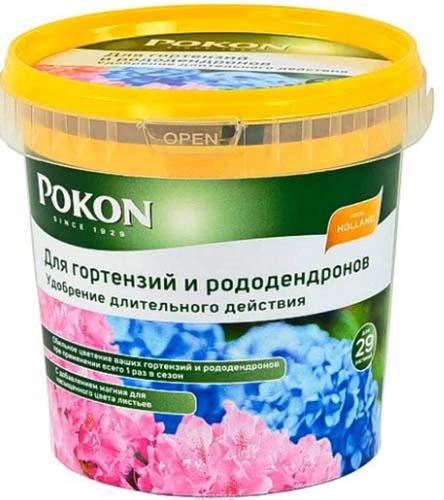
Soil acidification is not carried out
Note! The need for fertilizing, as well as acidification, arises about 2-3 years after planting, when the plant completely draws out all the juices (all nutrition) from the substrate with which the planting pit was filled.
If you want hydrangeas to bloom luxuriously and not suffer from chlorosis, then the soil under the hydrangeas should always be acidic, which means that it must be acidified periodically (at least once a month during the flowering period).
You can acidify the soil under hydrangeas with the following compositions and solutions:
- weakly acidic electrolyte solution (10 ml per 10 l of water);
- vinegar (100 ml of 9% vinegar per 10 liters of water);
- citric acid (20-40 g per 10 l of water).
Advice! Moreover, it is desirable to additionally add iron chelate to the above solutions or inkstone (20-30 grams per 10 liters).
You can regulate the color of hydrangeas by changing the acidity of the soil. So, the more acidic the soil, the more purple or blue the color will be, and, conversely, if the acidity is lower, then the inflorescences can be pink or crimson.
Worth knowing! Making blue hydrangeas out of pink is not so easy. Even if you have very acidic soil, but there is not enough movable aluminum in it, there will be no color changes. Therefore, you need a solution of potassium alum (30-40 grams per 10 liters, consumption for an adult plant - up to 2-3 liters), or you can use aluminum sulfate (dig into the soil, up to 500 grams per 1 square meter).
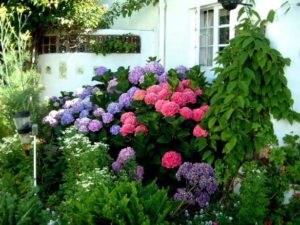
Incorrect pruning in spring and / or autumn
No trimming,for example actually you cannot achieve a chic and friendly flowering of a tree hydrangea, which blooms only on the shoots of the current year. Therefore, it can be argued that pruning directly affects flowering. But it should be understood that this does not apply to all hydrangeas. That is why it is very important to know the characteristics of your particular species and variety, because other species bloom on last year's shoots, and if you cut them every year, then the hydrangea simply cannot bloom.
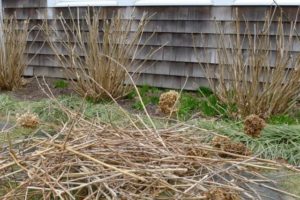
Important! Often in autumn pruning inexperienced growers remove flower buds. In this case, the hydrangea will not bloom next year. Therefore, most oftenhydrangeas are pruned in spring, although the essence of trimming does not change.
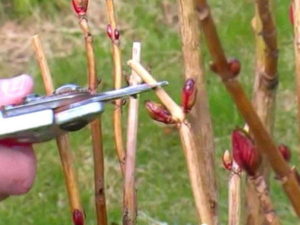
In addition, some types and varieties of hydrangeas form too many shoots, in this case, excess branches growing inside the bushes must be removed so that the bushes do not thicken. If timely do not thin out the bushes, then the inflorescences will be smaller, and on strongly thickened perennials, flowers may not appear at all.
It is equally important to periodically (every 4-5 years) carry out anti-aging pruning, because inflorescences will not appear on very old branches.
Video: how to achieve flowering of a tree hydrangea through proper pruning
By the way! You can read nuances spring and autumn pruning hydrangea in separate detailed articles on our website.
Lack of shelter for the winter
It is necessary to shelter hydrangeas for the winter in most regions of our country. This is done so that the flower buds do not freeze - in this case, the perennial will not bloom next year. However, not all types of hydrangeas need shelter. So, the tree-like and paniculate varieties are quite frost-resistant, but they should also be slightly hilled or mulched, while the large-leaved one must be covered for the winter.
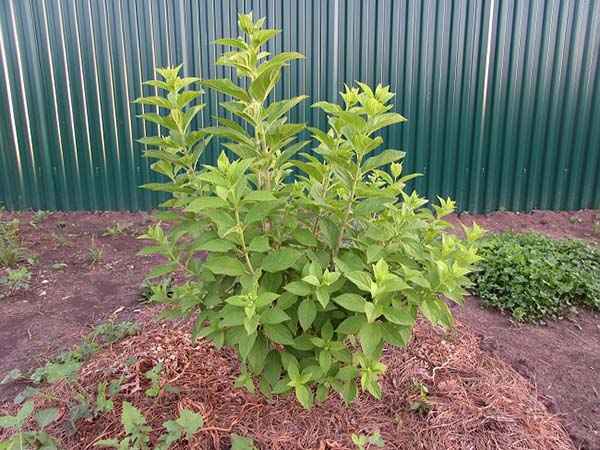
Before the onset of cold weather, all the shoots are tied together and covered with non-woven material. Or you can simply cover the stems from above with coniferous spruce branches, which will well protect the plants from temperature extremes. However, it is still better to install the frame on top and place the covering material on it.
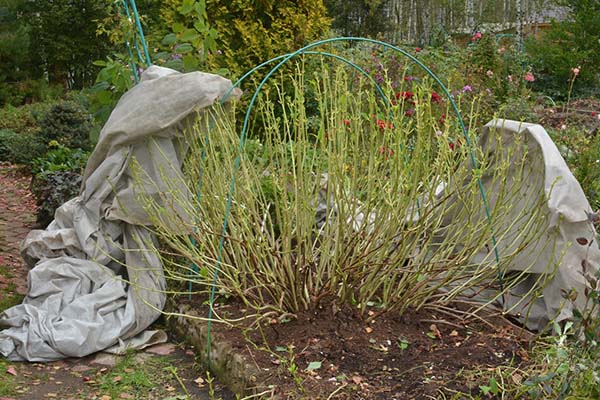
Important! About, what hydrangeas and how to properly cover them for the winter, read in detail in this article.
Video: why large-leaved hydrangea does not bloom and winters badly
Diseases and pests
Most often, hydrangea is not sick with anything, and it is rarely overcome by any pests. In addition, she can quite successfully resist such attacks on her own. But if the plant still got sick with something, and because of this its flowering stopped, then you need to urgently help it.
For example, hydrangea most often has chlorosis, which manifests itself in the fact that the leaf plates begin to fade, become light bilious, spots appear on them, and they begin to fall off, and the flower ovaries become smaller. This is due to the alkalization of the soil and the lack of iron in it. To defeat the disease, an increased amount of iron and an acidifier must be added to the soil for its normal and rapid absorption. A solution is suitable for this. ferrous sulfate or an iron chelate, as well as one of the acidifiers (sulfuric acid, vinegar or citric acid). For example, in a bucket of water, mix 20-40 grams of citric acid and 20-30 grams of ferrous sulfate.
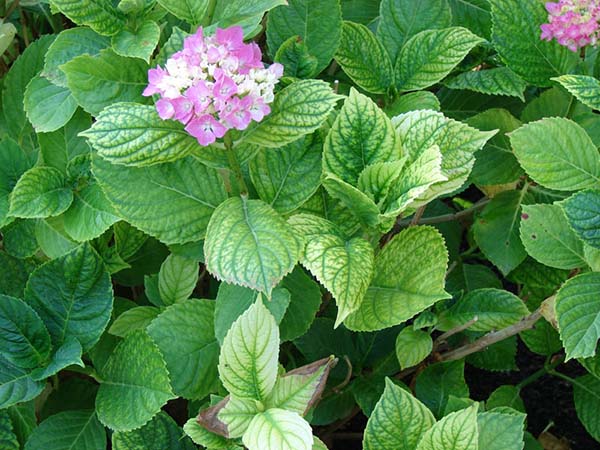
Fungal diseases "attack" hydrangeas very rarely and only when the soil is too moist. Therefore, to prevent them, the irrigation regime should be observed so that the soil is moist, but without stagnation of moisture in it. However, it happens that on hydrangea leaves you may notice powdery mildew... Treatment with a solution will help to cope with it. bordeaux liquid or copper sulfate.
Of the pests most often on hydrangeas can appear:
- slugs and snails;
By the way! How to deal with slugs and snails in the garden is described in detail in this material.
- spider mite;
- aphid.
But for strong and sturdy shrubs, attacks of such pests are not terrible. Usually, they can be dealt with using folk methods: spraying with soap or onion infusion. Or you can use insecticides such as Fitoverm, Fufanon or Actellik.
Thus, in conclusion, I would like to note that all varieties of hydrangeas are distinguished by long and abundant flowering, if these shrubs are properly looked after and initially planted according to all recommendations. However, it is worth recognizing that these flowers can hardly be called unpretentious, since if the irrigation regime is violated, improper feeding, lack of acidification, incorrect pruning, these perennial shrubs can stop flowering.But observing all the rules for caring for these perennials, there is no doubt that hydrangeas will thank their owners with abundant and lush flowering.
Video: how to achieve a gorgeous hydrangea bloom
Note! Perhaps the following materials will come in handy in solving your question (why hydrangea does not bloom and how to properly care for it): planting hydrangea in the spring and in the falltrimming in the spring and in the fall, shelter for the winter, a general article on preparing hydrangeas for winter and autumn care.

